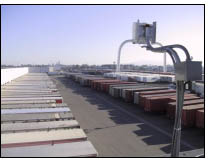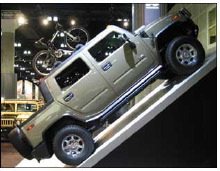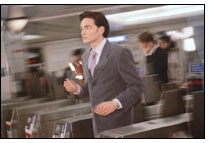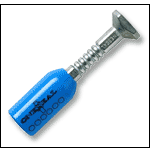Jan 16, 2005Radio frequency identification is an enabling technology, which means it doesn't provide much value on its own, but it enables companies to develop applications that create value. The Internet is another enabling technology, and just as the Internet enables companies to communicate, collaborate, educate, sell, entertain and distribute products, RFID enables companies to do many different things. This article looks at the major ways RFID is being used by companies today to create value and at some of the ways it might be applied in the future.
Keep in mind the RFID is used to identify objects or people. Its advantages are that it requires no human intervention, tags can usually be read even when a tag is not facing a reader antenna (tags can't be read through metal and some other materials), and the information can be transmitted to computers in real time. Typically, when a read reads a tag, it passes three things to a host computer system: the tag ID, the reader's own ID and the time the tag was read. By knowing which readers are in which locations, companies can know where a product is, as well as what it is, and because of the time stamp, they can know everywhere it's been.
Asset Tracking
It's no surprise that asset tracking is one of the most common uses of RFID. Companies can put RFID tags on assets that are lost or stolen often, that are underutilized or that are just hard to locate at the time they are needed. Just about every type of RFID system is used for asset management. NYK Logistics, a third-party logistics provider based in Secaucus, N.J., needed to track containers at its Long Beach, Calif., distribution center. It chose a real-time locating system that uses active RFID beacons to locate container to within 10 feet (subscribers, see Logistics Gets Cheaper by the Yard).
Air Canada is saving millions of dollars each year by tracking food carts used at airports around the world. It chose to place active transponders under the carts (passive tags were too hard to read on the metal carts) and readers on the entrance and exits of catering facilities around the world (subscribers, see Air Canada GETS Asset Tracking). It not only loses fewer carts and spends less time and money taking inventory, it also is able to better manage the movement of carts so there are always carts at the airport catering stations that need them.
RFID Journal has published case studies on other successful applications, including El Paso County's use of 915 MHz passive tags to track computers and IT and office equipment (Tracking Assets from Prairie to Peak); law firm Fish & Richardson P.C.'s use of 13.56 MHz tags to track files (RFID Brings Order to the Law); and a Singapore company's use of 13.56 MHz technology to track samples of construction concrete that must be tested to ensure building safety (Tracking Concrete Cubes for QA).
RFID has been used in manufacturing plants for more than a decade. It's used to track parts and work in process and to reduce defects, increase throughput and manage the production of different versions of the same product.
Johnson Controls, a Milwaukee, Wisc.-based suppler of car and truck interiors, has to supply seats, dashboards and other components to the big three automakers where the automakers want it, when they want it. Johnson Controls installed a 13.56 MHz system to track the various types of car and truck seats it supplies. The system has proved to be 99.9 percent accurate (subscribers, see Perfecting Just-In-Time Production).
Boeing has been using a 915 MHz system at it Wichita, Kansas, facility to track parts as they arrive, and as they move from one shop to another within the facility. In the past, bar codes associated with parts had to be scanned manually when a part went to an area where, say, it needed a special chemical treatment. Then it had to be scanned out again. If a part wasn't scanned, the company lost track of it. Now RFID tags track the movement of parts automatically, reducing errors and the need to have people look for parts needed on the manufacturing line (subscribers, see Boeing Finds the Right Stuff).
AM General is using an active RFID system to track parts bins on at its Hummer manufacturing plant in Mishawaka, Ind. (RFID Revs Up Hummer Plant). And Club Car made RFID an integral part of its new golf cart assembly line and cut the time it takes to build each vehicle—from 88 minutes to about 46 minutes—while ensuring that each car is built to an exact specifications (Golf Car Maker Scores with RFID).
Supply Chain Management
RFID technology has been used in closed loop supply chains or to automate parts of the supply chain within a company's control for years. A Procter & Gamble distribution facility in Spain used a 13.56 MHz system to increase throughput, reduce shipping errors and cut labor costs (subscribers, see RFID Speeds P&G Plant Throughput).
Paramount Farms, which processes about 60 percent of the U.S. pistachio crop and exports its products to more than 20 countries, is relies on RFID to help automate the processing the incoming shipments of pistachios from grower partners (subscribers, see Farm Harvests RFID’s Benefits).
As standards emerge, companies are increasingly turning to RFID to track shipments among supply chain partners. Canus, a Canadian manufacturer of skin care products made from goat's milk, is using RFID to reduce the cost of checking shipments to its retail customers, and it's looking to use RFID temperature sensors to monitor the condition of products in transit (see Soap Maker Cleans Up with RFID).
Retailing
Retailers such as Best Buy, Metro, Target, Tesco and Wal-Mart are in the forefront of RFID adoption. These retailers are currently focused on improving supply chain efficiency and making sure product is on the shelf when customers want to buy it (see Wal-Mart Lays Out RFID Roadmap).
Among the most talked about potential applications are the ability to automate the checkout process and eliminate lines and the ability to market to consumers who opt in to loyalty programs while they are making purchasing decisions. Experts envision people putting items into a shopping cart equipped with a computer, small display and RFID reader. When consumers that have opted into a loyalty program put a steak into the cart, they might get an ad for steak sauce or be told about wine that's on sale. When checking out, the consumer walks through a tunnel reader, has all the items in the car read automatically and pays with the swipe of contactless credit card. These applications require tags to be on virtually all items in the store—something that won't happen for at least a decade.
Payment Systems
RFID is all the rage in the supply chain world, but the technology is also catching on as a convenient payment mechanism. One of the most popular uses of RFID today is to pay for road tolls without stopping. These active systems have caught on in many countries, and quick service restaurants are experimenting with using the same active RFID tags to pay for meals at drive-through windows.
RFID is also catching on as a convenient way to pay for bus, subway and train rides. Boston, Washington, D.C., Seoul, and many other cities are switching from magnetic stripe cards to RFID cards because the RFID allows more people to pass through turnstiles fasters, reducing congestion, and the lack of mechanical parts in readers reduces maintenance (subscribers, see Smart Cards for Smart Commuters).
Many ski resorts in Europe use RFID lift tickets. In Japan, consumers can download movie tickets to their cell phones and enter a theater by swiping an RFID tag in the phone past a reader in a turnstile. MasterCard and Visa are also experimenting with RFID cards and key fobs for small payments usually made with cash.
Security and Access Control
RFID has long been used as an electronic key to control who has access to office buildings or areas within office buildings. The first access control systems used low-frequency RFID tags. Recently, vendors have introduced 13.56 MHz systems that offer longer read range. The advantage of RFID is it is convenient (an employee can hold up a badge to unlock a door, rather than looking for a key or swiping a magnetic stripe card) and because there is no contact between the card and reader, there is less wear and tear, and therefore less maintenance.
Active RFID tags can be combined with motion sensors so that when objects—say, weapons stored in military depots—are moved without authorization, an alarm is sounded. RFID tags can be put on laptops and files containing sensitive documents to make sure they are not removed from a building without authorization.
After the terrorist attacks on New York and Washington, D.C., in 2001, the U.S. Department of Transportation (DOT) conducted a number of tests of RFID seals to safeguard containers. Since it's impossible to check each of the millions of cargo containers entering United States ports each year, the DOT hopes to reduce the risk of terrorists sneaking weapons of mass destruction into the United States through the ports by putting an electronic seal on each container.
Seals are active RFID tags that have a bolt or some other mechanism for sealing a container. If the container is opened without authorization, that information is communicated to a computer the next time the RFID tag in the seal is read. Then, a warning can be sent and agents can check the container (see Securing Your Cargo With Seals).
Other Applications
There are many other innovative uses for RFID. One system uses active tags in a bracelet to locate children at theme parks (RFID Makes a Splash at Water Park). Intel has developed a prototype system that can help people suffering from Alzheimer's disease to function more normally (RFID Aids Alzheimer's Patients). Brink's, the security company, has created a system in France that destroys bills if they get too far from an RFID reader in an armored car (Brink's Arms Itself with RFID).
Wireless sensors represent the next stage beyond RFID. These can be passive or active RFID tags that are combined with temperature loggers, motion sensors, radiation sensors and so on. The U.S. military is funding research into simple RFID sensors that could detect pathogens in food. These could be used to protect the public against food-borne illnesses or even deliberate acts of terrorism.
Wireless sensors can also be tiny computers that run their own operating system, have onboard sensors and communicate data to one another. The NASA Jet Propulsion Laboratory in Pasadena, Calif., is working on a new generation of wireless sensor networks. In early pilots, these have been used to measure soil and air temperatures, humidity and light in the MacAlpine Hills region of Antarctica; to gauge the movement of water across a water recharge basin just west of Tucson, Ariz., to automatically turn on sprinklers in dry areas of the Huntington Botanical Gardens in San Marino, Calif. (subscribers, see NASA Creates Thinking RF Sensors).
As RFID technology evolves and becomes less expensive and more robust, it's likely that companies and RFID vendors will develop many new applications to solve common and unique business problems.




